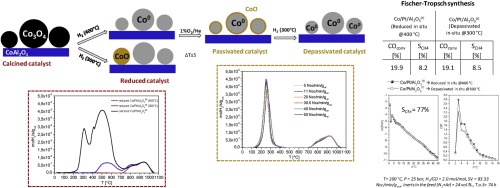Catalysis Today ( IF 5.3 ) Pub Date : 2019-02-25 , DOI: 10.1016/j.cattod.2019.02.069 Laura Fratalocchi , Gianpiero Groppi , Carlo Giorgio Visconti , Luca Lietti , Enrico Tronconi

|
Passivation of reduced cobalt-based catalysts is required prior to air exposure due to the exothermicity of the Co metal oxidation, which may lead to a significant increase of the temperature of the catalyst resulting in its degradation and in a potential fire hazard. This work shows the results of the passivation process carried out on a Pt-promoted Co-based catalyst supported on stabilized alumina at different space velocities in the range of 5–50 Ncc/min/gcat and constant O2 concentration of 1 vol.%. Increasing the O2 flow fed to the reactor, the specific amount of O2 consumed on the catalyst slightly decreases. Around 30% of Co metal particles are oxidized to CoO species in all the passivation treatments. These species are found to be much more reducible than the Co oxides species present on the calcined catalyst. Indeed, all the passivated catalysts are completely depassivated at a temperature which is significantly lower (300 °C) than that needed to fully reduce the calcined catalyst (400 °C). The temperature of the catalyst almost linearly increases with the increase of the O2 feed flow. Indeed, an abrupt increase of the catalyst temperature is observed for high O2 flows, resulting in a decrease of the Co° dispersion (i.e. increase of the average Co° crystallites size) after depassivation. This result is explained with the onset of sintering phenomena of the CoO species formed during passivation. The passivation treatment is found to be unsuitable for long-term catalyst protection, since a deep re-oxidation of the passivated catalyst is observed after two months of air exposure. The effectiveness of the catalyst passivation is eventually validated by running FT reactivity tests at industrially relevant process conditions. The activity of the calcined catalyst reduced in-situ at 400 °C is compared to that of the same catalyst reduced ex-situ at the same temperature, passivated at low O2 flow and depassivated in-situ at 300 °C. Interestingly, similar stability and reactivity, expressed both in terms of activity and selectivity, are obtained.
中文翻译:

钝化铂助钴基费托催化剂
由于金属钴金属的放热反应,在暴露于空气中之前,需要对还原的钴基催化剂进行钝化处理,这可能会导致催化剂温度的显着升高,从而导致其降解以及潜在的火灾隐患。这项工作显示了在以5-50 Ncc / min / g cat的范围和恒定的O 2浓度为1 vol的不同空速下,负载在稳定氧化铝上的Pt促进的Co基催化剂上进行的钝化过程的结果。 %。增加送入反应器的O 2流量,特定量的O 2催化剂上消耗的燃料略有减少。在所有钝化处理中,大约30%的Co金属颗粒被氧化为CoO物种。发现这些物种比存在于煅烧催化剂上的Co氧化物物种更具还原性。实际上,所有的钝化催化剂在比完全还原煅烧的催化剂所需的温度(400℃)低得多的温度(300℃)下被完全钝化。随着O 2进料流量的增加,催化剂的温度几乎呈线性增加。实际上,对于高O 2,观察到催化剂温度突然升高钝化后流动,导致Co°分散性降低(即,平均Co°微晶尺寸增加)。用钝化过程中形成的CoO物种的烧结现象开始解释了该结果。发现钝化处理不适用于长期的催化剂保护,因为在空气暴露两个月后观察到钝化催化剂的深度再氧化。催化剂钝化的有效性最终通过在工业上相关的工艺条件下进行FT反应性测试来验证。将在400°C下原位还原的煅烧催化剂的活性与在相同温度下在低O 2下钝化的相同催化剂的活性进行比较流动并在300°C下原位钝化。有趣的是,获得了以活性和选择性表示的相似的稳定性和反应性。



























 京公网安备 11010802027423号
京公网安备 11010802027423号